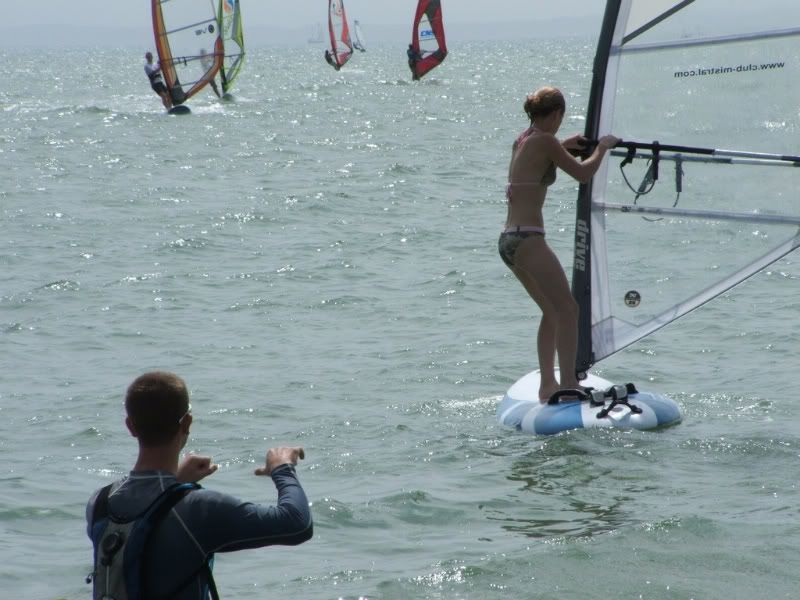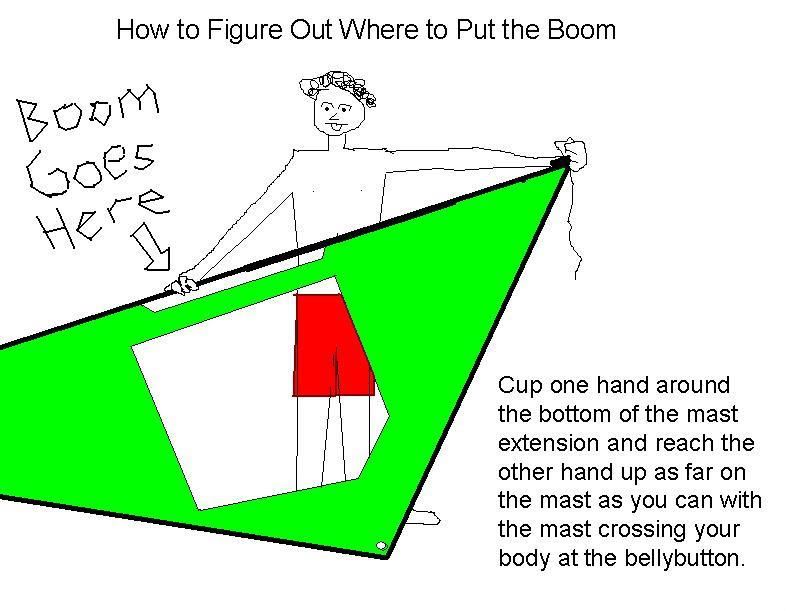Contrary to what you might think, knowing how to windsurf does NOT confer any ability to teach others.
This is because experienced windsurfers do everything by instinct. We make subtle moves and adjustments every moment in response to the feel of the board and rig interacting with the wind, the water, and our bodies. When it comes down to it, we can hardly even describe what we're doing, let alone convey it successfully to a beginner.
What we have to do as instructors is break down our complex actions and reactions into a set of verbal instructions that is short and simple enough to be understood, but complete enough that it will actually enable the student to go where she wants to go.

(Me teaching my sister at Club Mistral on Isla Margarita, Venezuela, Christmas '06)
The best way to learn how to teach is take an official windsurfing instructor course. I did the one through US Sailing, taught by Dietmar "Pete" Wells at Beach Sports in Hampton. It made a HUGE difference in my success rate for teaching and was well worth the money. If you're too cheap or too busy to take the course you should at least buy the handy reference manual; "Start Windsurfing Right".
In the meantime, here's my quick & dirty version of how to teach windsurfing:
1. Make sure the person you want to teach actually wants to learn. If not, don't bother. Note- If you REALLY want to teach that person, like if they're your your kid or something, you could try a sneaky approach. Get a SUP paddle for your longboard and let them dink around with that setup. Once they get some confidence on the board away from your overwhelming, instructorly presence, they may be ready to try it with the sail.
2. Make sure you have the right gear for the person you want to teach; a big board with a daggerboard AND a small, light sail with no cams. (No matter how gentle the wind is, your 6.5 sail is way too big for a beginner and your 140 liter shortboard is way too small.) This gear calculator will give you an idea of what to use: LINK. Also, make sure you put the boom at the right height. Around shoulder or neck height is good for beginners. (See the diagram for how figure out boom height.)

3. Pick a good spot (no waves, chop, current or shoreline obstacles) and a good day (5-10 knots sideshore is ideal).
4. Orient the student to the wind at the site. Make sure they can point into the wind and they know what "upwind" and "downwind" mean. Have them put their back to the wind and point their arms out to the side and explain that the directions they are pointing are the main directions that they will be sailing in, and that its not possible to sail directly upwind.
5. Start the instruction with a short lesson on land. Take the fin off, screw in a mast base, and set the board up perpendicular to the wind on the beach or the grass.
-Show the student what the different parts of the board are (front, back daggerboard, mast base) so they will know what you're talking about when you're shouting instructions later.
-Show where to stand when uphauling (feet on the centerline of the board, shoulder width apart, straddling the mast base) and when sailing (front foot next to mast base, pointing forward, back foot on centerline just behind daggerboard knob). Explain that you always need to keep your weight in the "sweet spot" of the board around the middle, even when you are walking around the front during a tack (see diagram).

-Show the right way to uphaul. Start crouched down, back straight, then slowly roll backward and stand up, going hand-over-hand on the uphaul rope until the top. Keep arms and back straight the whole time. At the end the body should be making a "V" with the mast. Butt sticking out is bad. Knees slightly bent is good. Let the student practice uphauling and getting into this position a couple times.
-Show how to turn the board when holding the uphaul by swinging the sail toward the back of the board to turn upwind or towards the front to turn downwind. If the student is light and you don't mind spinning your board on the ground you can simulate a tack while they swing the sail back and walk around the front of the board.
-Next, show how to grab the boom correctly with the front hand. Let go of the uphaul with what will be the front hand, point to the nose of the board with that hand (this helps to identify the correct hand), then cross over the hand that's holding the uphaul and grab the boom as close as possible to the mast. Then let go of the uphaul rope.
-From this one-handed position, the next move is to put the feet in the sailing position. Note that the feet go into the sailing position before the back hand goes on the boom.
-Show the student how to pull the sail up in front of them and slightly to windward BEFORE they grab the boom with their back hand. If they don't bring the sail up past vertical like this, they will have to bend their back and stick their butt out to reach the boom, and they will round upwind as soon as they sheet in on the water. This is one of those things that experienced windsurfers do without realizing but usually fail to teach.
-Once the sail is in position where they can grab the boom easily with their back hand, have them do it. Then show them how sheeting the sail in and out turns on and off the power, and let them try it until they're used to it. Tell them that they can ALWAYS turn off the power by letting go with their back hand, but that they should NEVER let go with the front hand.
-Briefly explain that steering while underway is done by leaning the whole rig toward the tail of the board to turn upwind, or leaning it towards the front to turn downwind.
6. On the water, let them uphaul and get in a good "V" position while they're holding the top of the uphaul. (Hold on to the tail of the board so they don't go anywhere.) Show them how to keep the board pointed perpendicular to the wind by swinging the sail toward the front or back of the board as needed.
7. Have them practice tacks until they can turn around in place without falling down. Don't even bother showing them how to actually sail until they are comfortable tacking. Otherwise they will immediately sail out of earshot and you will be shouting indecipherable tacking instructions while they panic.
8. Go on to the actual sailing instruction part, which they should be prepared for since their on-land lesson. You will have to do lots of reminding and correcting at first. A good goal for the first lesson is to be able to sail out, tack, and come back to the beach. If they get that down, then you can work on the steering and upwind / downwind direction control a little more, but don't try to cram too much into the first lesson. (See #8).
9. Quit while you're ahead; don't wait until your student is exhausted and frustrated. Resist the temptation to always push your student to the next level. It's especially important to keep sessions short and sweet if you're trying to teach a reluctant significant other. If that's the case, make sure you always follow up the session with some kind of rewarding activity that your sweetie likes.
10. General notes: Be patient. Be helpful but not overbearing. Don't condescend. Share stoke if the student is doing well and give self-esteem-boosting encouragement if the student is having a tough time.

6 comments:
Brilliant.
If I really want to look for an hair in the egg (literal translation of a weird italian saying for nitpicking), I'd pick:
"Show the student how to pull the sail up in front of them and slightly to windward BEFORE they grab the boom with their back hand"
I usually don't have my students bring the mast any upwind of the center line of the board.
That will prevent them from bending the front elbow too much and from losing their balance and falling upwind (eventually getting backwinded and hit by the mast in the process) if hit by a side wave and/or a 20 knots whirling gust... Welcome to teaching beginners in Maui!
Also, stepping back before putting the back hand on the boom... that depends very much on the board. Some boards like to be moving first, otherwise they would point upwind too much if the student steps back without sheeting in first.
One general comment.
Based on my experience of teaching thousands of beginners in probably the worse place in the world for teaching beginners, I came to the conclusion that the probability of success depends on:
10%: student ability
10%: instructor ability
10%: equipment
70%: conditions.
Bit frustrating for the instructor...
James, you should have put this post in an appendix of your dissertation... good job!
PS. Mmmm... now that I read it again, maybe I misinterpreted the first point. You say "slightly to windward", maybe you don't mean upwind of the center line of the board... well, even better. It's pretty much perfect then.
PPS. One more thing. Considering the above described harsh conditions I usually teach in, I like to set the right expectations at the beginning of the lesson. I warn them that 90% of my students at the end of the lesson say that it was more difficult than they thought and that the success will depend also on their attitude. If they thing they're going to be good at it, they might get frustrated. I tell them the only goal should be to have fun and if they laugh at themselves every time they fall, they're gonna have a lot of it!
Doesn't always work though...
Croatians also use that 'look for an hair in the egg' saying - it's 'traziti dlaku u jajetu'.
Ivo
Good points Cammar- Bringing the sail too upright before sheeting in can break up the "V" position and send students tumbling backwards. But with the student positioned somewhat behind the mast before they sweep the sail up in front of them it usually works ok, at least in the light wind conditions and big wide boards I teach on. I agree about conditions being super important. Even a few inches of chop can make it really hard for a newbie, so yeah, a "conditions disclaimer" for the students is important. :)
Ivo- There are worse things than a hair in the egg. Check this out-
http://www.abc.net.au/news/stories/2008/05/16/2246597.htm
Great tips, I'll be sure to use them this summer (esp. the steps going from uphaul to boom)!
One important item that I'd add is vision, one of Guy Cribb's core skills. He says, look where you want to go, and your body will follow. Too often beginners get caught up looking at the boom & sail, or their feet (akin to staring at the steering wheel or brake pedals while driving), instead of the water (or road) ahead.
Cribby also makes a point about creating bad habits by letting the beginner tack with a lot of little steps around the mast. Instead, he suggests learning the heel-to-toe foot twist right from the beginning.
Cheers!
Jeff- Good tip about looking where you want to go. I use that one with newbies but forgot to mention it in the post. :) I'll have to check out those Guy Cribb videos to see how he teaches the foot twist.
Good article again.
In my experience, and I think you were first on all those points:
- must want - pick the right candidates (unless you're a school and you don't care)
- boom right height - underarm (a.k.a. armpit) high, no higher.
- right gear - obvious
- make falling fun. It's not about not getting wet
- make learning fun - too many long faces on the beach nowadays
- set expectations early "will take a few to several outings", etc. Else they expect to be sailing off after 10 minutes.
- it's all about conditions - on-shore, light, sandy bottom. Wait for the right conditions, don't set a date and go if it's blowing cows.
Even to this day (20+ years), I still learn new tricks only when in perfect conditions, else I wait...
Post a Comment